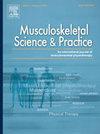Validity of a qualitative visual method for diagnosing forward head posture
IF 2.2
3区 医学
Q1 REHABILITATION
引用次数: 0
Abstract
Introduction
Forward head posture (FHP) is quantitatively diagnosed by measuring the craniovertebral angle (CVA). A qualitative visual method has recently been introduced but the validity of this method has not been confirmed. The present study aimed to clarify the validity of the visual method, using CVA methods as a standard.
Methods
CVAs were measured photographically, adopting reported criteria of less than 53° or 55° to diagnose FHP. The visual method defined a positive FHP as the back of participant's head not touching the wall while standing with heels, buttocks and shoulder blades touching the wall. These studies were performed in healthy young adults. Rates of positive FHP were compared between methods. Positive predictive values were then calculated for FHP based on CVA methods.
Results
The study population comprised 37 men and 43 women (21 ± 1 years). With the visual method, 41% (33/80) had FHP. With CVA methods using criteria of 53° and 55°, 34% (27/80) and 50% (40/80) displayed FHP, respectively. However, the visual method exhibited a male predominance in the group with FHP compared to that without FHP, together with high body mass index (BMI). Positive predictive values were 0.42 and 0.61 for FHP by CVA methods using criteria of 53° and 55°, respectively.
Conclusion
The visual method exhibited positivity rates approximating those using CVA methods of 53° and 55°. However, the relatively low positive predictive values suggested the visual method was inferior to CVA methods, partly due to the increased positivity rate for males with high BMI.
定性视觉方法诊断头部前倾姿势的有效性
通过测量颅椎角(CVA)来定量诊断前倾头位(FHP)。最近引入了一种定性的视觉方法,但这种方法的有效性尚未得到证实。本研究旨在以CVA方法为标准,阐明视觉方法的有效性。方法影像学测量scvas,采用小于53°或55°的标准诊断FHP。视觉方法将正面FHP定义为参与者的后脑勺不接触墙壁,而脚跟,臀部和肩胛骨接触墙壁。这些研究是在健康的年轻人中进行的。比较两种方法的FHP阳性率。然后基于CVA方法计算FHP的阳性预测值。结果男性37例,女性43例(21±1岁)。采用目测法,41%(33/80)有FHP。采用53°和55°标准的CVA方法,分别有34%(27/80)和50%(40/80)显示FHP。然而,与没有FHP的组相比,视觉方法在有FHP的组中显示出男性优势,并且身体质量指数(BMI)较高。采用53°和55°标准的CVA方法对FHP的阳性预测值分别为0.42和0.61。结论目测法的阳性率与CVA法的53°和55°相近。然而,相对较低的阳性预测值表明目测法不如CVA法,部分原因是高BMI男性的阳性率增加。
本文章由计算机程序翻译,如有差异,请以英文原文为准。
求助全文
约1分钟内获得全文
求助全文
来源期刊

Musculoskeletal Science and Practice
Health Professions-Physical Therapy, Sports Therapy and Rehabilitation
CiteScore
4.10
自引率
8.70%
发文量
152
审稿时长
48 days
期刊介绍:
Musculoskeletal Science & Practice, international journal of musculoskeletal physiotherapy, is a peer-reviewed international journal (previously Manual Therapy), publishing high quality original research, review and Masterclass articles that contribute to improving the clinical understanding of appropriate care processes for musculoskeletal disorders. The journal publishes articles that influence or add to the body of evidence on diagnostic and therapeutic processes, patient centered care, guidelines for musculoskeletal therapeutics and theoretical models that support developments in assessment, diagnosis, clinical reasoning and interventions.
 求助内容:
求助内容: 应助结果提醒方式:
应助结果提醒方式:


